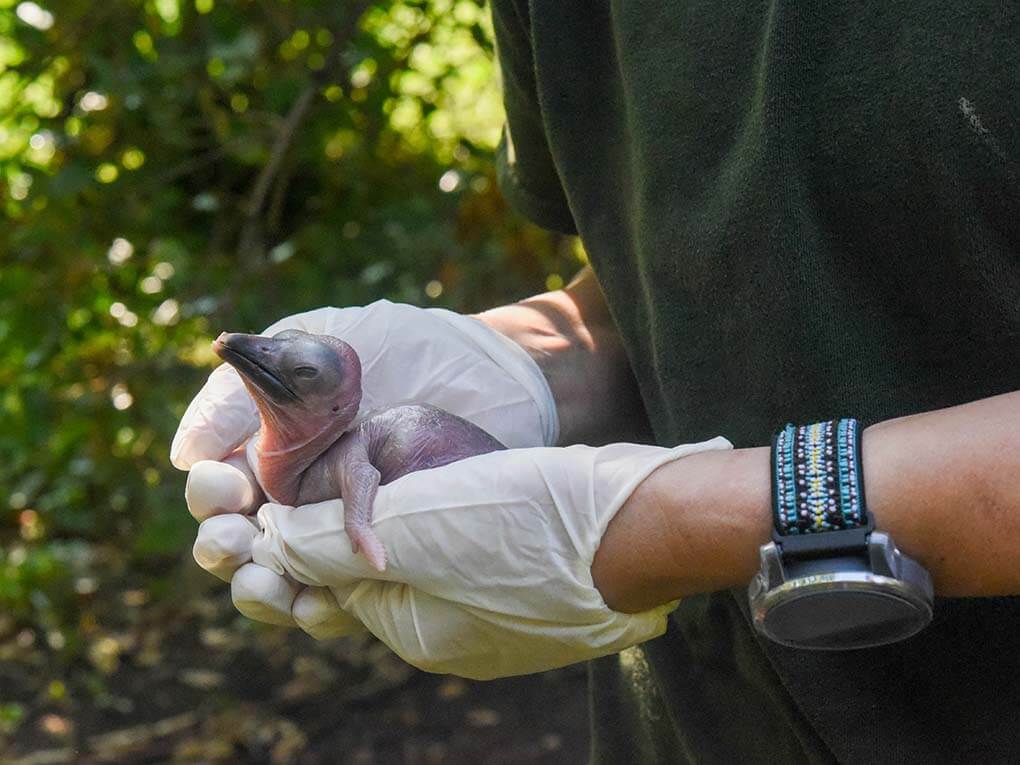Maryland Zoo welcomes Northern ground hornbill chick
The chick is the first born to parents Blue and North
Northern ground hornbill chick born at the Maryland Zoo (Image courtesy of Maryland Zoo)

Maryland Zoo announced the birth of a Northern ground hornbill chick, the first for parents Blue and North. The duo was suggested for breeding by the Northern Ground Species Survival Plan, which was coordinated by the Association of Zoos and Aquariums. However, it took longer than expected due to North, the male, not cooperating.
“In the past, each time Blue laid eggs North would push her out of the nest and destroy them, so we had to develop a nest box that only she can get into,” explained Jen Kottyan, curator of Birds at the Maryland Zoo, in an organizational release.1
To keep North from pushing the eggs out, the keeper team used a part wine barrel and created an opening that was wide enough for Blue to be able to get inside, leading to a successful birth. Blue will now remain in the box with her chick to get extensive prenatal care, especially since it will take about 2 weeks before the chick will fully open its eyes and 80-90 days until it fledges.
These birds are large black birds that can grow up to 3 feet tall, which is about the size of a wild turkey, and can weigh 8-10 pounds.2 They are native to the African Savannah north and south of the Sahara Desert and can live for about 17 years and will lay 1-2 eggs.
When it comes to nesting season, adult Northern ground hornbill females will typically not seal themselves in the nest like other hornbill species. However, there are some who do by using a mixture of mud, food, and droppings. Once the female lays her eggs, they need to be incubated for 37-41 days. It is common for only one chick to make it to fledging, but if there are 2 chicks, they will fight for food from the parents with the firstborn having the stronger advantage.2 When the offspring is down to 1, the chick will fledge after 3 months and will receive food from the parents for up to 9 months.1
“This is a learning curve for the new parents. So far so good. We’re optimistic about the chick’s long term viability based on what we’re seeing,” said Kottyan.
These birds are considered vulnerable, with habitat loss being a significant threat to these birds. They are also at risk of being hunted by some native African tribes who will stuff the heads of adult Northern ground hornbill birds as a disguise when they are hunting game.
The keepers at the Zoo will continue to closely monitor the family.
Reference
- NORTHERN GROUND HORNBILL CHICK HATCHES AT MARYLAND ZOO. News release. Maryland Zoo. July 27, 2023. Accessed August 8, 2023. https://www.marylandzoo.org/news-and-updates/2023/07/northern-ground-hornbill-chick-hatches-at-maryland-zoo/
- The Maryland Zoo. Northern ground hornbill. The Maryland Zoo. Published November 1, 2017. Accessed August 8, 2023. https://www.marylandzoo.org/animal/northern-ground-hornbill/